LUIGI AMEDEO MORERA, was born in Saint Etienne, in the French region of Loire, on 27 April 1913, the son of two Italian immigrants: Giuseppe Florindo Morera and Teresa Marchini. As a child he grew up between France and Varallo (VC), on the Italian side of the Alps in Piedmont, where his family was originally from. The father worked as a construction sites’ manager for the Roland company in Paris, and personally oversaw the building of the family house in Drancy, and of the Junior High which Luigi attended, in Cartygny.
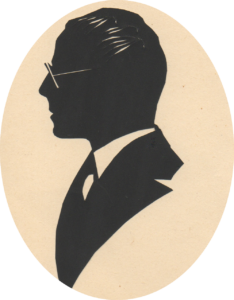
A Black-and-white cutout of himself. One of the earliest examples of design developed as teaching tools at the Pigier Institute in the early 1900s
Luigi’s first memory is that of a 5 years old kid, witnessing the amazing reactions of joy and euphoria that erupted from people in Varallo’s Caffe’ Commercio, after the announcement made by Diaz, declaring the end of WorldWar I. He will attend primary schools in Varallo, then, 2 years later, cross the Sempione pass once again, to return to Paris, where he will settle until 1932.
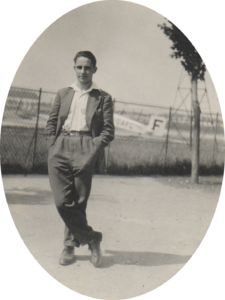
Luigi as a young of 18, with the airport of Bourget-Paris in the background.
He was always passionate about aviation as the “way of the future” and recounted to family his memory of when, as a child of 14 he went at Bourget Airport. He first witnessed Nungesser and Coli departure on 8 May 1927 during their attempt to cross the Atlantic by plane. After that he was again at Bourget, together with an immense crowd, to witness the arrival of Charles Lindbergh, for his first successful transatlantic flight, which landed on 21 May 1927. In his words: “Everyone knew that the plane was about to arrive. It had been seen approaching the coast, so we were all waiting… we just were not sure where or when exactly would he land. When he arrived at Bourget the crowd tore down the fences and rushed toward the airplane. There were thousands of people. They carried Lindbergh over their shoulder ecstatic. As for the airplane… it was torn to pieces…everyone grabbed a part of it. I was able to get a small section of the wing and avoiding being trampled to death, ran back home with it. The next morning the schoolteacher was talking about this momentous event to the whole class… in my youth I saw it as a chance to get a bit of glory for myself, so I told everyone what I had done the previous evening, and showed the piece of the airplane. The teacher took it, to show it around… that was the last I saw of it… The Airplane that they have at the Smithsonian…, it’s not the original one… they had to do emergency repair to what was left of it!” (here he usually laughed with nostalgia).
In 1928 the continued correspondence with friends in different nations pushes him to begin collecting Postcards.
An accomplished sportsman, he was a member of the famous Randonneurs Parisienes from 1931 to 1935, with the title of AUDAX COMPLET.
The title was achieved after the following qualifications: 1.5km run, followed by 3km obstacles run (clocked at the Longchamp hippodrome), followed by 10km run, followed by 100km walk (Paris-Rouen), followed by a 200km, a 300km and a 1200km bicycle run (Paris-Brest and return in 4 days), followed by 3km river swim following the current and 3km against the current (river Marne), followed by a 20km boat racing following the current and 20km against the current (river Marne).
He later shifted his attention to mountaineering with moderate success, where he was a lifetime member of the CAI (Italian Alpine Mountaineering Association).
He recounted (laughing) that, called for compulsory military service by the Italian army, the doctors discovered he had a minute heart defect “Precluding him from strenuous physical activities“. He was immediately dismissed from the military and never served during World War II.
aaaaaaaaaaaaa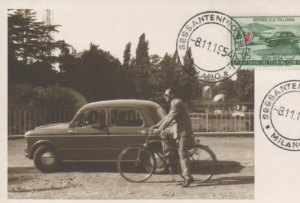
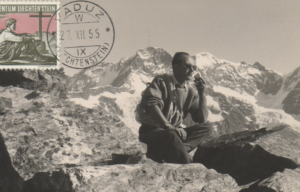
These two Maximum Cards reflect both his wit and his passions. He is portrayed in both, the left one taken in Parco Sempione in Milan, the second one on the top of the Tagliaferro mountain (alt. 2964 metres) with the southern side of the MonteRosa on the background.
He became a French Language and Literature’s professor following his graduation from Paris’ PIGIER Institute of advertising in 1932. Throughout his career he continued to be passionate about art and became the author of numerous prestigious poster campaigns, like the ones for the PARIS’ SIX DAYS CYCLING RACE, the first FRENCH AIRLINES LATECOERE for the Mediterranean (never published), and some sketches never published: the PHILIPS light bulb; the BALTO brand cigarettes, the ISOTTA FRASCHINI car and others.
In 1934 he was asked by the french government to choose naturalisation, in view of the increasing enmity between the fascist government and the french one. Because his family was all in Italy he chooses Italian nationals. Shortly afterwards all his properties in France are taken away from the French government. He comes back to Varallo.
During World War II he was politically active for the Italian government, but never forgot the Arts, which he would pursue incessantly throughout his life, both as a promoter and as an artist. After the end of World War II he will be arrested and processed as a fascist commander, but then fully absolved of any wrongdoing.
His gentle character, his love for freedom of expression and human rights, his generosity and love for the arts helped carrying him beyond the recriminations that followed the fall of the fascists at the end of 1945.
Thanks to his multi-language upbringing and his connections with the wool industries of the areas between Biella and Varallo, he’ll work as CEO to some of the most important European wool manufacturers, including the famous Filatura ALESSANDRO ZEGNA S.p.a.
In 1948, on a train from London back to Italy he encounters for the first time his future wife, Teresa Clerici. Luigi ‘s mother however will remain opposed to the woman, so it will be only after her death that he will propose and marry Teresa in 1971. They will remain happily married until her death in 1991.
Throughout all of this time his passion with Postcards and Philately did not diminish, to the degree that by the year 2000 he commanded one of the most important collections worldwide, comprising over 400,000 pieces, a great number of which are MAXIMUM Postcards. Preserved unaltered to date, the MORERA COLLECTION includes currently more than half a million items: postcards, envelopes, stamps, postmarks, engravings, catalogs, drawings, paintings, books and historical documents.
His words on Maximum cards clearly portray him as the pioneer of art and communication that he was:
“…Postcards […] constitute an ever updating encyclopaedia where everything that exist is painted and discussed. […] It’s the life of the world carried by images“
It is an undeniable fact that with the developing of the digital world this banner have been passed to medium like Facebook, YouTube, Instagram and many more.
In the Cold War’s atmosphere of the 1970s he works hard to develop cultural exchanges with Bucharest and travels back and forth from Rumania, organising Philatelic events, demonstrating the power of art and culture as a bridging force between antagonistic governments. In 1970 he also helps organising an exhibit about his friend Eros Donnini, left behind and sneered at by the Italian Poligraphic Institution. Donnini will later be acclaimed as one of the best Stamp engravers in the world.
His day-job in the wool trade allowed him the opportunity to travel all over the world, and he used these chances to increase his knowledge and experience in the philatelic world, becoming the internationally recognised expert on Maximaphily.
On 22-23 November 1975, together with 7 other Philately friends in Bologna he puts down in writing the AIM foundation’s declaration, the Italian Maximaphily Association.
Luigi works incessantly until 1991, creating philately exhibits, publishing articles for European and American specialized publications, co-founding the Maximaphily branch for FIP, and as honorary member of International Maximaphily circles and FIP International Juror.
Across his philatelic career he promoted and actively participated in the creation of Italian stamps and also in hundreds of philately EXPO around the world.
He will retire from most active participation in philatelic events on 14-15 June 1997, at the competition “MaxiVarallo ’97” where he will show, outside the competition, a great part of his 70 years of work in the philatelic world. In a side-note he jokes: “I am possibly today one of the few people alive that can say to have one of his postcards travelling, under his name, on the Zeppelin airship…” , referring of course to a time where air travel was not the norm.
aaaaaaaaaaaaaaaaaaaaaaaaaaaaaaaaaaaa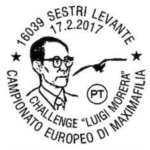
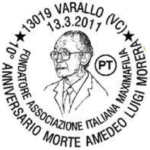
The impact Luigi had on the philatelic world cannot be understated, as much as for elevating its artistic and cultural contents as for promoting the aspects of friendship, kinship and connection that ties us all. The Post Office of Varallo issued a special Postmark in commemoration of the tenth year of his passing, and the city of Sestri Levante issued a Postmark to celebrate the European Championship of Maximafilia that occurred in Chiavari on 17~19 February 2017.
Until the day of his death, on 13 March 2001, he was always found working in his studio, at his beloved Olivetti Linea88 typewriter (Personal computers were not yet as common as now), promoting arts and culture in all its forms, for all people, all over the world.
#TheMoreraCollection #LuigiAmedeoMorera #Postcard #MaximumCard #Philately #Maximaphily #SaintEtienne #Loire #France #Varallo #Piedmont #Pigier #PigierInstitute #Bourget #BourgetAirport #Nungesser #Coli #NungesserAndColi #Lindbergh #CharlesLindbergh #SpiritOfStLouis #RandonneursParisienes #AudaxComplet #CAI #Philips #Balto #IsottaFraschini #AlessandroZegna #Bucharest #Rumania #ErosDonnini #FIP #FederationInternationaleDePhilately #AIM #ItalianMaximaphilyAssociation
